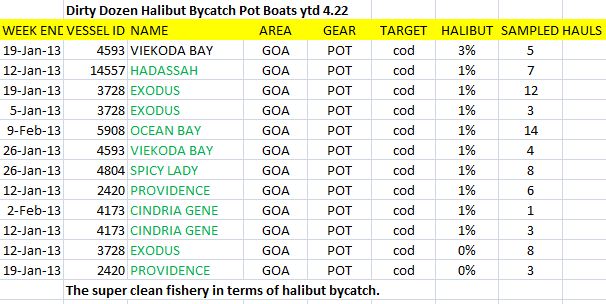One vessel, the CP (catcher/processor) Golden Fleece lost its special exemption to the 100% observer coverage for CPs with the restructured observer progam. (See Old and New 50 CFR below). We have argued that when trawlers are observed, their behavior changes; they hide their bycatch by fishing cleaner grounds and making other changes in order to appear to be clean fishing. If indeed, the CP Golden Fleece had now to fish 100% observed, her recorded bycatch should change too. Golden Fleece would be forced to fish as usual without an opportunity to hide her bycatch. Using NMFS data let's take a look.
 |
| Chinook salmon numbers in blue, the observer numbers in red. |
Conclusion. Allowing trawlers to game when to fish clean, obscures the true impact of their fishing on the resources in the GOA. When the restructured observer program reduced the percentage of observed trawling, it mostly likely allowed the trawlers to hide their actual bycatch. Therefore, NMFS has colluded to hide the impact of trawling on the GOA, while emphasizing the bycatch of other gear groups.
---Addendum---
Old 50 CFR 679.50:
(ii) Amendment 80 vessels in the GOA. Except for the F/V GOLDEN FLEECE (USCG Documentation Number 609951), all Amendment 80 vessels, except when directed fishing for scallops using dredge gear, in the GOA must have onboard at least one NMFS-certified observer for each day that the vessel is used to harvest, receive, or process groundfish in the GOA management areas or adjacent waters open by the State of Alaska for which it adopts a Federal fishing season.
New 50 CFR 679.50:
(2) Groundfish and halibut fishery full observer coverage category—(i) Vessel classes in the full coverage category.The following classes of vessels are in the full observer coverage category when harvesting halibut or when harvesting, receiving, or processing groundfish in a federally managed or parallel groundfish fishery, as defined at §679.2:
(A) Catcher/processors;
The Golden Fleece Hits the Halibut Hard Too.
The graph representing the Golden Fleece's increase in halibut PSC bycatch when fully observed is not as dramatic as it is with King Salmon, but probably deserves airing. Not quite double the increase, but still telling.
Obviously halibut bycatch was on the upswing in 2012, but when you remove the blinders of selected observation there is a 61% increase in halibut PSC bycatch over 2012, and 900% over their reported bycatch of halibut in 2011. Remember, the Golden Fleece has a hold capacity of at least 200,000 pounds, so we are talking roughly 4000 pounds of halibut per trip. She made 26 trips to the end of September. 100,000 pounds of halibut?
Who is getting fleeced here?
Keep yer flippers wet.


































